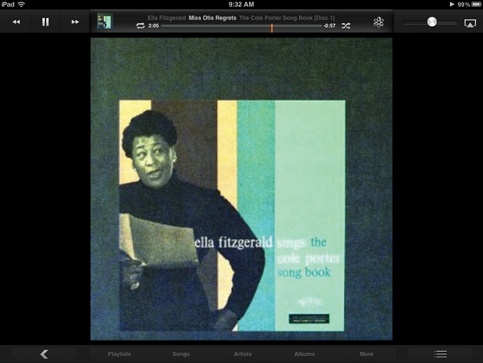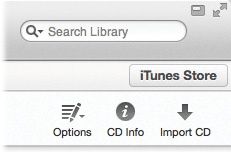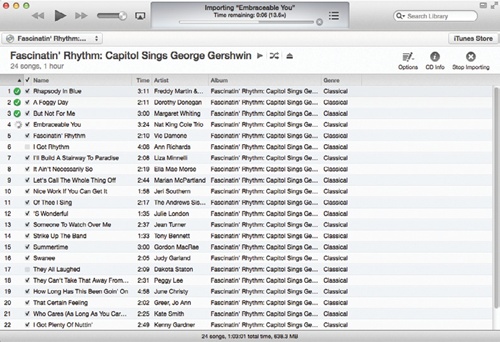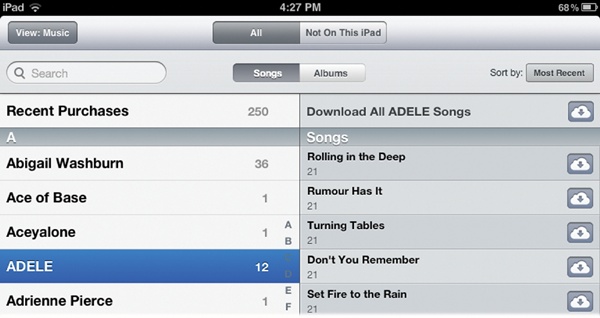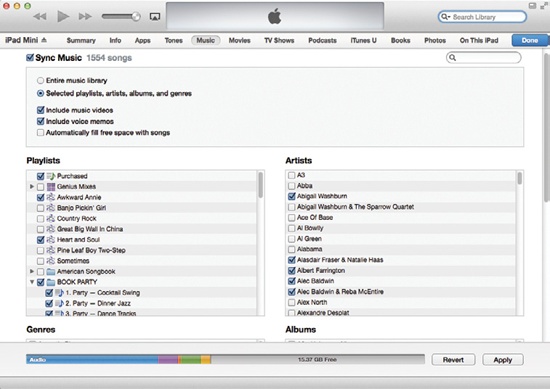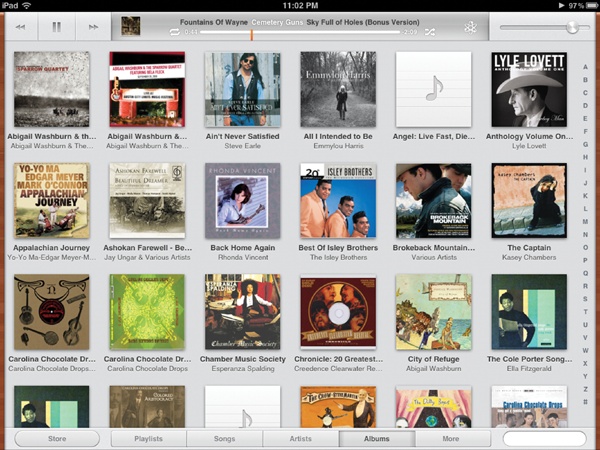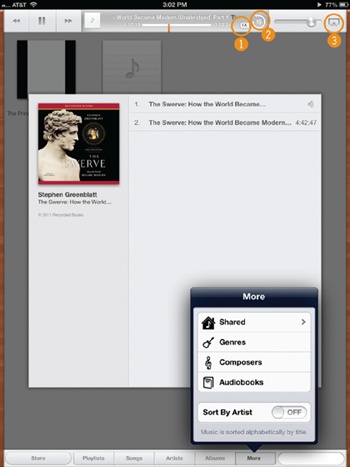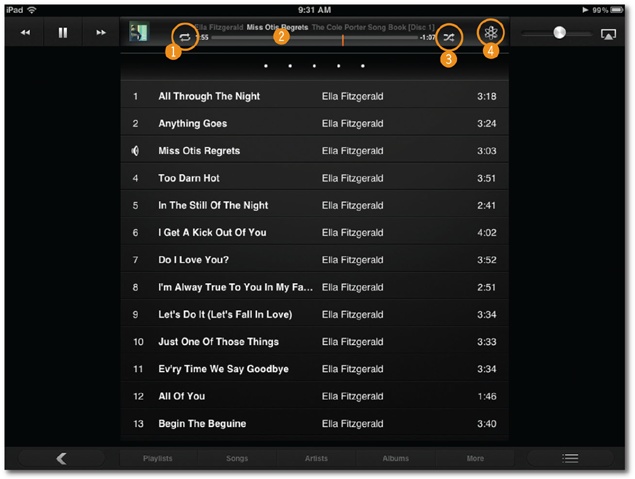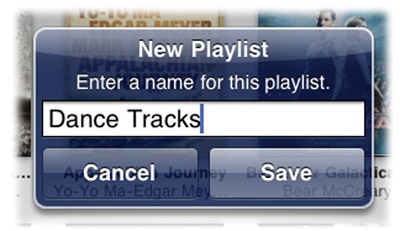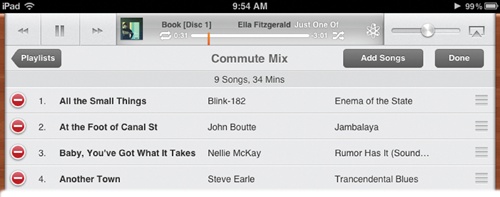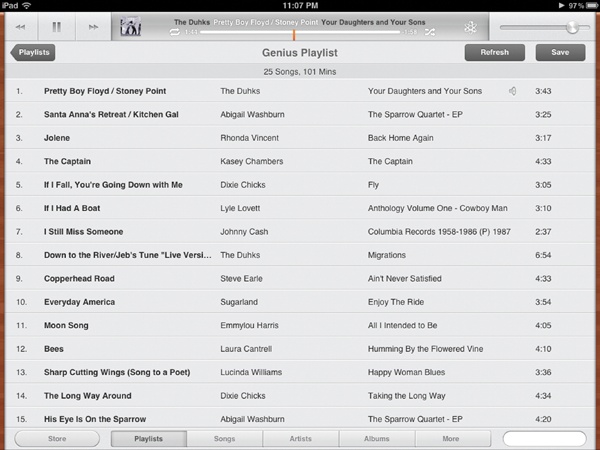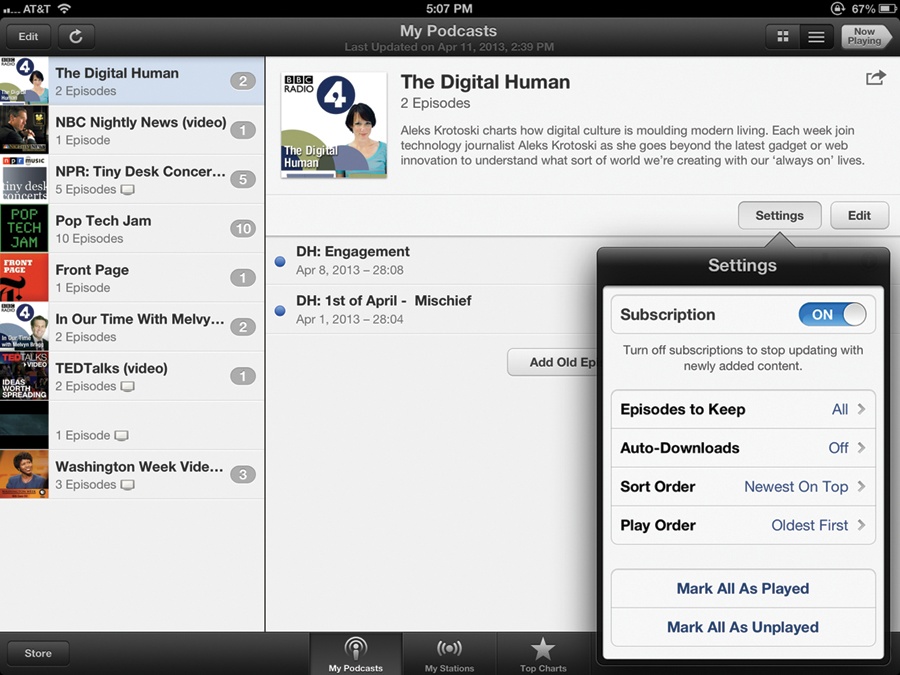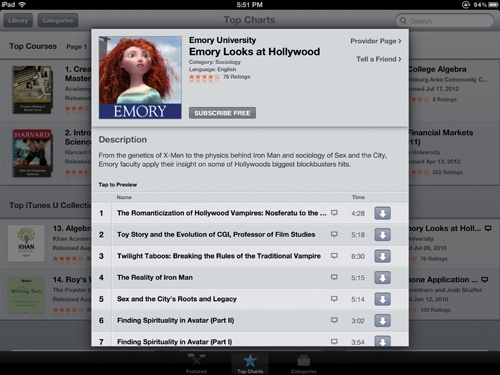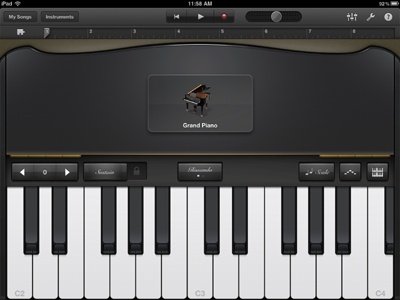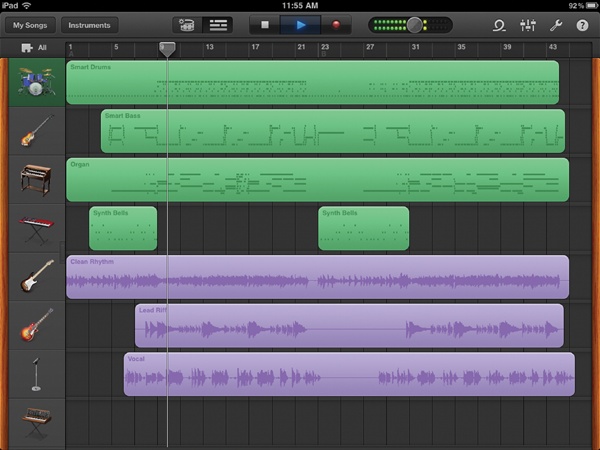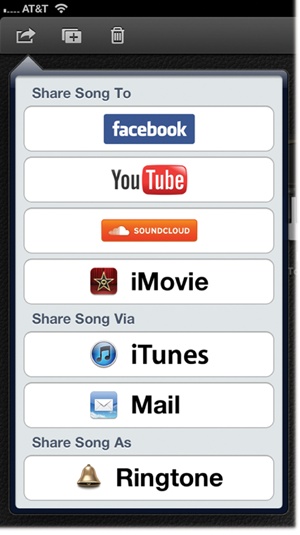Chapter 14. Manage and Play Music and Other Audio
You’ll learn to:
Import music from CDs
Buy music in iTunes and other online stores
Download audiobooks and podcasts
Sync audio files from iTunes to your ’Pad
Create your own playlists
WHEN APPLE ANNOUNCED THE first iPad way back in January 2010, many technology critics dismissed it as “a giant iPod Touch,” before going back to complaining about other things they hadn’t actually experienced. Although that particular response was snarky, it was also correct. Partly, anyway. Among many other things, the iPad is a giant iPod Touch. And what a handsome flat-screen jukebox it is.
Thanks to its larger size, the iPad makes playing music a breeze—it’s easy to find the tracks you want, create your own playlists, control your music, and admire full-screen cover art on the bigger screen. And if you like podcasts and iTunes U lectures, Apple offers free apps for both.
Granted, the iPad is a bit bulky to haul to the gym or schlep along for your morning jog, but it’s a great music machine for other situations—like when you have a stack of email to get through and you want to bliss out to a little Yo-Yo Ma.
Whether you’re after background music or front-and-center playback controls, this chapter shows you how to get your iPad singing. And if you pony up $5 for Apple’s GarageBand app for iPad, you may even find yourself singing along to your own songs. Play on!
Get Music and Audio for Your iPad
HAVE ABSOLUTELY NO MUSIC or audio files on your computer, ready for transfer to your iPad? Here are a few ways to get them there. (If you’ve had an iPod for years and have the music-transfer thing down cold, feel free to skip to the next page to see how the iPad organizes your music once you get it there.)
Import CD Tracks to iTunes
You can use iTunes to convert tracks from your audio CDs into iPad-ready digital music files. Start up iTunes and stick a CD in your computer’s disc drive. The disc icon appears in the Library pop-up menu and the program asks if you want to import the CD into iTunes. (If it doesn’t, click the Import CD button at the top-right of the iTunes window.) If you’re connected to the Internet, iTunes automatically downloads song titles and artist information for the CD. (Yes, strange as it may seem, music managers like iTunes don’t get information about an album from the album itself, they search for it in a huge database on the Web.)
Once you tell iTunes to import a CD, it begins adding the songs to your library, as shown below. You can bring in all the tracks or skip the ones you don’t want by turning off the checkboxes next to song titles. Eject the CD when iTunes finishes. Once you have the songs in iTunes’ library, sync your iPad with iTunes to copy the music over to your tablet.
Buy Music in the iTunes Store
Another way to get music on your ’Pad is to buy it from the iTunes Store (The iTunes Store). Once you have an iTunes account (Set Up an Apple ID), you can buy and download audio directly from your iPad (The Wireless iTunes Store) or via iTunes on your desktop PC. To shop from your computer, click the iTunes Store icon on the left side of the iTunes window, browse away, and buy. Then sync your iPad with iTunes.
If you bought music through your computer or through another iOS device, you can also use iTunes in the Cloud (Use iTunes in the Cloud to copy those tracks to your iPad. Just tap Home→iTunes→Purchased. At the top of the screen (shown below), tap either All or Not On This iPad to see either everything you’ve ever bought from iTunes, or just the songs that don’t yet have a home on your tablet.
Flick through the Artists list on the left and tap one. On the
right side of the screen, tap ![]() next to each song you want to download. You can
download all the tracks by an artist by tapping
next to each song you want to download. You can
download all the tracks by an artist by tapping ![]() at the top of the list.
at the top of the list.
Get Music from Other Online Stores
Although it’s usually the most convenient, the iTunes Store isn’t the only place you can buy music for your ‘Pad. If you’re on the prowl for new ear candy, consider these inexpensive—and sometimes free—options:
Amazon. The Store That Sells Everything has at least 20 million songs you can download to your computer, add to iTunes, and sync over to your iPad. Take a stroll to amazon.com/mp3.
eMusic. You can find 13 million tracks at www.emusic.com, plus download-helper software to sling it all into iTunes.
The Internet Archive. More than a million free recordings can be found at www.archive.org, including thousands of Grateful Dead live jams, old-time radio shows, and podcasts.
Sync Music, Audiobooks, and Podcasts
ONCE YOU CONNECT YOUR iPad (by Wi-Fi Sync or USB cable) and it shows up in iTunes, you can modify all the settings that control what goes onto (and comes off of) your tablet. Thanks to iTunes’ scrollable screen full of checkboxes and lists, it’s easier than ever to get precisely what you want on your iPad.
To sync all or just some of your music, click the iPad button in the iTunes window and then click the Music tab on the next screen. In addition to synchronizing songs and playlists by title, you can sync them by artist and genre. Just turn on the checkboxes next to the items you want to transfer to the iPad, click the Apply button, and then click Sync to move your music over.
Click the Books tab to get to the options for syncing audiobooks. Click the Podcasts tab to set up syncing for your favorite free shows from iTunes’ podcast directory. Synced podcasts land in the iPad’s optional Podcasts app (Use the Podcasts App).
Read on for details about playing all this fresh audio on your iPad.
Tip
Want to prevent iTunes from trying to sync your iPad every time you connect the USB cable—especially if you’re connecting it to someone else’s computer? To bypass the sync just once, hold down the Shift and Control keys on a Windows PC (⌘-Option on a Mac) right after you plug in the USB cable and wait until the iPad pops up in iTunes. To permanently put the kibosh on iTunes’ activity, choose Edit→Preferences→Devices (iTunes→Preferences→Devices) and turn on the checkbox next to “Prevent iPods, iPhones, and iPads from syncing automatically.”
Explore the Music Menu
THE IPAD’S MUSIC APP handles all the songs and albums on your iPad, no matter where you got them. For playing audio and video podcasts, see Use the Podcasts App. If you’re a student at iTunes U, see Go to School at iTunes U.
Your iPad divvies up the Music screen into three distinct areas:
Controls & Volume bar. All the iPad’s audio playback controls (like volume and the next/previous buttons that move you between songs or audiobook chapters) sit at the very top of the screen, along with the album cover and time counter for the current track. The control bar also holds icons for Loop (
 ), Shuffle (
), Shuffle ( ), and the playlist-spawning Genius feature
(
), and the playlist-spawning Genius feature
( ) that automatically generates a playlist
based on songs like the one currently playing. The volume slider is
in the top-right corner.
) that automatically generates a playlist
based on songs like the one currently playing. The volume slider is
in the top-right corner.Bottom bar. The bottom of the Music window concerns itself with organizing your music—or obtaining more of it. Tap the Store button in the lower-left corner to pop online and shop for new tunes. The buttons to the right of the Store button let you sort your music by playlist, song title, artist name, or album name. Tap More to see other audio-sorting choices, like Genres and Composers, and any Shared libraries (Use iTunes Home Sharing on Your iPad) on your network. You can also turn on the Sort By Artist button to sort your collection by artist name. Don’t see what you’re looking for anywhere? Tap a few keywords into the Search box in the lower-right corner.
Main window. No matter which type of audio file you choose, the iPad displays the track name at the top of the screen. Most views show cover art at one size or another, except Songs, which displays your tracks as a text list, and Genre, which uses themed art to represent music styles, like Folk and R&B. On the Playlists screen, click the New button to create a fresh playlist, and then tap the songs you want to add.
Play Music
TO PLAY A SONG, tap its title on the screen. If you sort your music collection by album, tap an album cover to spin it around and reveal its song list, and then tap a title to hear that song. Use the playback controls at the top of the screen to adjust the volume, play and pause songs, and jump between tracks.
To fill the iPad’s screen with the cover art from the album or song you’re listening to, tap the small album-cover thumbnail at the top of the screen. This takes you to the Now Playing screen (see Control the Now Playing Screen).
To hear a playlist, tap the Playlists button at the bottom of the screen, tap the playlist icon, and on the list of songs, tap the title of the first track to kick off the music. Should the iPad screen go to sleep while you’re rocking out, the album cover of the current song appears on your Lock screen when you wake it back up. (Don’t have any album art, just a drab music note? See Fetch Missing Album Art.)
Getting tight for space? You can delete songs directly off your iPad to recover drive space while you’re on the go. When you see a track on an album or playlist that you want to get rid of, swipe the name of the song with your finger, and then tap the Delete button that appears.
Tip
The iPad lets you play music even as you move on to other tasks, like Safari browsing or note-writing. If you need to call up the playback controls, double-click the Home button (see Use the Home Button). You can also swipe up using multitasking gestures to get to the controls, as Use Multitasking Gestures on the iPad explains.
Play Audiobooks
AUDIOBOOKS LIVE WITHIN THE Music app, although it’s not always obvious. To see your collection, tap More on the bottom bar of the Music app, as shown below. (If you haven’t loaded any audiobooks onto your iPad, you won’t see the category listed on the menu.) Here’s what you can do during playback:
Speed up or slow down the narrator’s voice. Cycle through the
 button for normal speed,
button for normal speed,  for double-time (if the person is talking too
slowly), and
for double-time (if the person is talking too
slowly), and  for half-speed (in case the person is talking
too fast).
for half-speed (in case the person is talking
too fast).Tap the encircled 15 icon here to replay the last 15 seconds of a recording, in case you spaced out and missed something.
Tap the AirPlay icon (
 ) to stream the audiobook through a pair of
compatible speakers or to a television connected to a second- or
third-generation Apple TV (Play iPad Videos on Your TV). Stream and Mirror Files with AirPlay has more on
setting up and using AirPlay.
) to stream the audiobook through a pair of
compatible speakers or to a television connected to a second- or
third-generation Apple TV (Play iPad Videos on Your TV). Stream and Mirror Files with AirPlay has more on
setting up and using AirPlay.
Do you like podcasts and other forms of spoken-word content as well as audiobooks? See Use the Podcasts App for using Apple’s free Podcasts app on your iPad, and Go to School at iTunes U for getting an education on the equally free iTunes U app.
Control the Now Playing Screen
TO KEEP THE ALBUM art tidy on the Now Playing screen, the iPad displays audio playback controls only when you tap the screen (circled below). Here’s a key to the iconography:
Play/Pause (
 ) button. If
you have music playing, the Pause button looks like a pair of
upright sticks (
) button. If
you have music playing, the Pause button looks like a pair of
upright sticks ( ). If you tap
). If you tap  to pause a song, it turns into the triangular
Play button (
to pause a song, it turns into the triangular
Play button ( ). Tap it to resume your tune.
). Tap it to resume your tune.Previous, Next (
 ,
,  ). These
buttons, which evolved from the rewind and fast-forward buttons on
old tape players, perform the same tasks they used to—only better.
Tap
). These
buttons, which evolved from the rewind and fast-forward buttons on
old tape players, perform the same tasks they used to—only better.
Tap  to go to the start of a song (or if you’re
at the start, to jump to the previous song).
Tap
to go to the start of a song (or if you’re
at the start, to jump to the previous song).
Tap  to skip to the next song. You can also swipe
your finger across the album art to jump to the next or previous
track on an album.
to skip to the next song. You can also swipe
your finger across the album art to jump to the next or previous
track on an album.If you hold down one of these buttons instead of just tapping it, you rewind or fast-forward through a song, just like bygone days of tape players. When you press the icon, the track audibly zips by, and goes faster if you continue pressing.
Volume. Drag the big round Dot of Loudness in the upper-right corner forward or backward in its slider to increase or decrease the volume. (You can also use the physical volume control on the right side of the iPad.)
With the playback controls visible, the familiar buttons for
Playlists and other options appear at the bottom of the screen. Tap one
to jump out of the album’s full-screen view and off to your chosen
destination. Tap the arrow in the bottom-left corner to return to the
full list of songs. Tap ![]() (circled above) at the bottom of the screen to
see a track list like the one on the next page.
(circled above) at the bottom of the screen to
see a track list like the one on the next page.
Now, those are the obvious controls. Then there are the ones that look like iPad hieroglyphics, numbered here for your illumination.
Loop button. Got a particular album, playlist, or song you just can’t get enough of? As it plays, tap the Loop button (
 ) to turn it solid (
) to turn it solid ( ). That tells the iPad to repeat the music
until you tap Loop again.
). That tells the iPad to repeat the music
until you tap Loop again.Scroll slider. Perched at the top of your screen, this slider displays your progress through a track. It also displays, in minutes and seconds, how much of a song you’ve heard and how much you have left to hear. You can jump around in a song by dragging the little orange bar. Above that slider, you can see where the tune falls in the current song list or album.
Shuffle button. If you don’t want to hear songs on an album or in a playlist in their usual order, tap Shuffle (
 ) to mix things up.
) to mix things up.Genius playlist. Tap the
 icon to make a Genius playlist based on the
song currently playing. Make Genius Playlists on the iPad has
details.
icon to make a Genius playlist based on the
song currently playing. Make Genius Playlists on the iPad has
details.
To assign a song a one- to five-star rating, double-tap the album
art to get the song list, and then swipe the series of dots
(![]() ) above the list to convert them into stars
(
) above the list to convert them into stars
(![]() ). Since the stars also sync back to iTunes, you
can use your personally assigned ratings to craft Smart Playlists (Smart Playlists: Another Way for iTunes to Assemble Song
Sets) that draw only
from your favorite music.
). Since the stars also sync back to iTunes, you
can use your personally assigned ratings to craft Smart Playlists (Smart Playlists: Another Way for iTunes to Assemble Song
Sets) that draw only
from your favorite music.
Make Playlists
YOU HAVE A FEW ways to make playlists—those personalized sets of songs made up of tunes you think go great together. You can create them in iTunes and sync them over to your iPad, you can assemble them on the iPad itself, or you can have the iPad make them for you.
In iTunes, one way to make a new playlist is to choose File→New Playlist. When the “untitled playlist” label appears in the iTunes Source list, it’s highlighted so you can type in a better name. Then drag songs from your library onto the playlist name. You can select a bunch of tracks at once (hold down the Control key as you click) and drag them to a playlist en masse, or you can create a new playlist from the grouping (choose File→New Playlist From Selection). Then sync the new playlist to your iPad (Manually Sync Your iPad).
You can make a playlist from tracks in the iPad’s music collection, too:
On the main Music screen, tap the Playlists button at the bottom. On the Playlists screen, tap New. In the box that pops up, give the playlist a memorable new name and then tap Save (right).
A list of all your iPad-resident songs pops up. Each time you see one worth adding, tap its name (or the
 button). You can also tap one of the buttons
at the bottom of the screen, like Artists or Albums, to sort your tunes—or add tracks from other
types of audio files, like audiobooks or podcasts. The Add All Songs button makes it easy to grab a
screenful.
button). You can also tap one of the buttons
at the bottom of the screen, like Artists or Albums, to sort your tunes—or add tracks from other
types of audio files, like audiobooks or podcasts. The Add All Songs button makes it easy to grab a
screenful.When you finish, tap Done. Your playlist is ready to be heard.
To rework a playlist, tap its name and then tap the gray Edit button. You can add tracks to the mix by tapping the Add Songs button.
You can reorder the songs in a playlist, too. Note the “grip
strip” at the right edge of song titles (![]() ). With your finger, drag these handles up or down
to rearrange the tunes. When you finish, tap Done. To remove a song from
a list, tap the universal iPad Delete symbol (
). With your finger, drag these handles up or down
to rearrange the tunes. When you finish, tap Done. To remove a song from
a list, tap the universal iPad Delete symbol (![]() ), and then tap the Delete confirmation button on
the right side. (Remember, while the song’s no longer in your playlist,
it’s still in your library.) To zap a whole playlist, tap the Playlists
button, press your finger down on the doomed list, and then tap
), and then tap the Delete confirmation button on
the right side. (Remember, while the song’s no longer in your playlist,
it’s still in your library.) To zap a whole playlist, tap the Playlists
button, press your finger down on the doomed list, and then tap
![]() in the corner.
in the corner.
Make Genius Playlists on the iPad
APPLE’S GENIUS FEATURE IN iTunes and on the iPad analyzes your music collection and automatically generates Genius playlists and Genius Mixes for you. These are sets of songs (or, in the case of Mixes, sets of songs based on a music genre) that the Genius thinks sound good together.
Genius playlists are a little more personalized than Mixes, because you have to choose the first song, which inspires the Genius to select songs that go with it. Genius Mixes, on the other hand, appear in iTunes only when you have enough songs in a genre to create a playlist—tap Playlists to see your song sets. You can sync Mixes over from iTunes or have your iPad automatically generate them.
To create a Genius playlist:
Tap
 at the top of the Music window. When the song
list appears, tap the track you want to use as the foundation of
your song set.
at the top of the Music window. When the song
list appears, tap the track you want to use as the foundation of
your song set.The Genius whips together a playlist. The album cover of the track you picked represents the whole song set. Tap the cover to see the Genius’s song selections. If you don’t like the results, tap Refresh to get new tunes.
If you love the work of the Genius, select or tap the Save option at the top of the screen. To start over again, tap New.
To delete a Genius playlist, press its icon on the Playlists
screen and then tap ![]() . As in iTunes, the iPad names its Genius lists
after the song you chose as the cornerstone of your mix. When you sync
your iPad, your Genius playlists get copied over to iTunes.
. As in iTunes, the iPad names its Genius lists
after the song you chose as the cornerstone of your mix. When you sync
your iPad, your Genius playlists get copied over to iTunes.
Tip
If a currently playing song is totally the vibe you want for a
playlist, you can summon the Genius from the Now Playing screen (Control the Now Playing Screen). Just tap the screen to
call up the playback controls, and then tap the atom-shaped Genius
icon (![]() ) in the top-right corner.
) in the top-right corner.
Use the Podcasts App
IN IOS 6, PODCASTS have a new home. No longer part of the iPad’s Music app, these free audio and video shows have moved on over to their own app—creatively named Podcasts. You can download it free in the App Store (Chapter 8).
Once you install the app, tap it open. Tap the My Podcasts button at the bottom of the screen to see your shows. If you don’t have any podcasts, tap the nearby Store or Top Charts buttons. Either one whisks you to Apple’s online podcast directory, where you can browse and sample shows, just as you can with music and videos—except with podcasts, you can stream shows over an Internet connection if you don’t feel like downloading them for offline listening.
Here’s what else you can do with podcasts:
To download an episode of a podcast from Apple’s directory, tap the download arrow next to the show’s title.
To subscribe to the podcast—that is, to have iTunes alert you to new episodes as they become available—tap the Subscribe button on the podcast’s directory page.
Once you subscribe, you can have your iPad automatically snag new episodes for you. Tap open a show on your iPad, tap the Settings button on the podcast’s description page (shown below), and tap Auto-Downloads→On. Tap the Edit button to delete old shows, or to mark them as played or unplayed. On the same page, tap
 to email, tweet, Facebook post, or message a
link to the show.
to email, tweet, Facebook post, or message a
link to the show.Tap the My Stations button at the bottom of the window to create “stations” of selected podcasts that automatically update with new episodes. You can also create playlists made up of single episodes from various podcasts.
When you have a podcast playing, the familiar audio playback controls appear above and below the show’s art, along with buttons for sharing the podcast by mail or message, setting the Sleep Timer function (so you can drift off at night and have the iPad turn itself off automatically), and adjusting the audio playback speed.
Go to School at iTunes U
PODCASTS AREN’T THE ONLY free content available from Apple. The company’s iTunes U project, which it calls “the world’s largest digital catalog of free educational content,” boasts more than 500,000 audio and video lectures, presentations, documents, ebooks, and other files that you can download right to your iPad. All you need is Apple’s iTunes U app (free from the App Store), an Apple ID (Set Up an Apple ID), and room on your tablet for the knowledge of the world.
While some schools have incorporated iTunes U into their official lesson plans, odds are you’d like to do your learning a la carte. If that’s the case, open the iTunes U app and tap the Catalog button in the upper-right corner. As with the iTunes Store, the App Store, and iBooks, browse and download away.
Free courses from Harvard, Yale, Stanford, Oxford, and other internationally renowned universities await you, as well as content from the Library of Congress and the Museum of Modern Art. Like the Podcasts app (opposite page), you can subscribe to and download iTunes U courses and lectures with tap.
Once you sign up for some free classes, press the Library button in the upper-right corner to see your course materials. Everything sits on a virtual bookshelf (which looks exactly like the shelf in the iBooks app, but with darker varnish on the virtual wood). Tap an item on the shelf to open it—if you downloaded several lessons from the same course, you’ll see a list so you can tap the one you want to hear.
Unless you’re participating in an iTunes U course through an academic institution, you’re not getting college credit for your learning. But still—where else can you hear an Ivy League lecture for such low tuition? Go iTunes U!
Make Music with GarageBand
SO FAR, THIS CHAPTER has focused on playing other people’s music on your iPad—which can be quite fun, because some people are pretty darn good at making music. But what if you have your own tunes in mind with no place to turn them into real music?
Good news. You can compose songs in an electronic eight-track recording studio that just happens to be thinner than most music-theory textbooks. For a mere $5, you can get a copy of Apple’s GarageBand app, which turns your iPad into that studio. Just visit the App Store and search for GarageBand.
The GarageBand app is the tapworthy cousin to Apple’s desktop GarageBand program, which is part of Apple’s iLife suite of creative software for the Mac. Over the years, many Mac users have composed their own songs, edited audio files, and generally had a good time noodling around in GarageBand. The iPad app works on all models of the tablet, so you don’t have to have the latest hardware to start your own one-’Pad band.
The first thing you see after you open the app is the Touch Instrument browser, which displays several screens’ worth of digital instruments—guitars, bass guitars, drums, and keyboards. You play the music-makers right there on your iPad by tapping and swiping. The virtual instruments sound just like their real-life counterparts, but they’re much easier to haul around. (Hey, when was the last time you could fit a fully playable grand piano in your backpack?)
Got musically inclined friends with iPads, iPhones, or iPod Touches—and GarageBand? Tap the music note on the toolbar (above) to create a Jam Session that links all the iOS devices together over a Bluetooth connection so everyone can play their Touch instruments at once for a rockin’ good time.
Once you get the hang of playing, you can record your efforts. And with the iPad’s built-in microphone, you can even add your own vocal accompaniment.
As you record the different elements of your song and save them to the iPad, you can begin to piece together each part into a unified composition on the track-mixing screen, shown at the top of the next page.
You can layer eight tracks for each song, and include some of the 250 professional music loops that come with the app to enhance your song. (If you’re new to the music business, loops are short audio snippets of percussion and other instruments that automatically repeat, hence the sensible name “loop.”)
When you finish a song, you can email it as an AAC file right from your iPad. You can also export it into
iTunes the next time you sync up your tablet; there, you can either play
the song or burn it to a CD. Just tap Edit, select the tune and tap
![]() on the My Songs screen to get to the sharing
menu. You can also upload your tune directly to Facebook, YouTube,
SoundCloud—or send it to the iMovie app (if you have it)
for use in another media production. You can even make it a
Ringtone.
on the My Songs screen to get to the sharing
menu. You can also upload your tune directly to Facebook, YouTube,
SoundCloud—or send it to the iMovie app (if you have it)
for use in another media production. You can even make it a
Ringtone.
With its huge collection of instruments, mixing controls, and
sound effects, GarageBand may seem a little overwhelming at first. But
don’t get stressed—the app comes with its own tutorial file. Tap the
wrench icon at the top of the screen and then tap Help on the menu. And
if you tap the ![]() icon in the top-right corner, GarageBand displays
helpful yellow tooltips on-screen (shown below) to guide you as you go
along. And finally, there’s a whole manual for the app online at http://tinyurl.com/axmaster.
icon in the top-right corner, GarageBand displays
helpful yellow tooltips on-screen (shown below) to guide you as you go
along. And finally, there’s a whole manual for the app online at http://tinyurl.com/axmaster.

